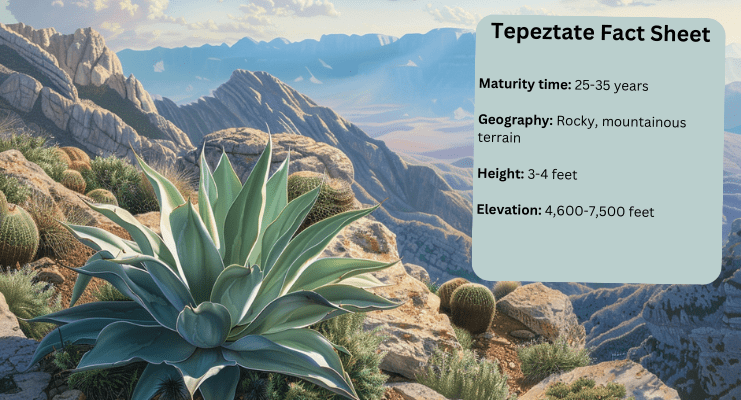Tepeztate Mezcal is a revered, prized jewel of mezcal crafted from the Agave Marmorata plant. This agave is a notoriously difficult plant to work with due to its scarcity, the rugged and mountainous terrain it grows, and exceptionally long maturation period.
With the longest maturation cycle of any mezcal-=producing agave, the Marmorata takes between 25-35 years to mature in the wild, making it increasingly rare and sought after. This extended growth period contributes to the higher price of Tepextate compared to the more common Espadin and Karwinsii varieties. Further, each agave plant only yields ~10-40% of finished mezcal product as Espadin (depending on the plant), making it a very inefficient variety of agave.
As a result of these difficult production hurdles, it’s very rare to find a high quality bottle of tepeztate for under $100.
Tepeztate Fact Sheet
- Maturity Time: 25-35 years
- Geography: Mountainous, rocky terrain.
- Height: 3-4 feet
- Elevation: 4,600-7,500 feet

Wild Agave
Tepeztate is a wild agave, meaning it grows naturally in the wild and is not being cultivated. This is in contrast to domesticated agaves like Espadin, which are commonly grown in plantations. The wild nature of Tepeztate contributes to its unique flavor profile, which it takes from its surroundings, soil, air, altitude and many more factors.

Tepextate or Tepeztate?
You might have noticed two different spellings for this type of mezcal – Tepextate and Tepeztate. Both terms, along with various regional names such as Pichomel, Pitzometl, Maguey Curandero, Huiscole, or Becuela, refer to the same type of agave and mezcal. The difference in spelling is due to regional variations in language and pronunciation, but they both refer to the same agave plant and the mezcal produced from it.
Tepeztate Tasting Notes
Tepeztate mezcal is distinguished by its fresh flavor and herbal notes along with rich and robust spicy flavors and mineral elements. Its flavor profile is significantly deeper and offers more complexity compared to espadin mezcal.
Tepeztate Team Favorites
If you’re going to buy a tepeztate, you might as well invest in a good bottle. There aren’t many shortcuts here, so you’re truly going to get what you pay for. You can find a few bottles for $100, but the quality will be very hit-and-miss.
Best Tepeztate Mezcal
El Jolgorio – $160USD

| Maguey | Tepeztate |
| Type | Joven |
| State | Oaxaca |
Solid Tepeztate Mezcals
Rey Campero – $130USD

| Maguey | Tepeztate |
| Type | Joven |
| State | Oaxaca |
Del Maguey – $140USD

| Maguey | Tepeztate |
| Type | Joven |
| State | Oaxaca |
Mal Bien – $120

| Maguey | Tepeztate |
| Type | Joven |
| State | Oaxaca |
Affordable, but drinkable Tepeztate bottles under $100
Espina Negra – $75USD

| Maguey | Tepeztate |
| Type | Joven |
| State | Oaxaca |
El Bujo – $90USD

| Maguey | Tepeztate |
| Type | Joven |
| State | Oaxaca |
Tepeztate Price Level
Due to its long maturation period and the challenging conditions in which it grows, Tepeztate mezcal tends to be more expensive than other varieties. This particular agave has a relatively low sugar content in its core, requiring a larger quantity of agave plants to produce a single bottle of mezcal. For example, approximately 100 pounds of Tepextate are needed to produce a bottle of distilled spirits, while only 40 pounds are required for Espadin for the distillation. The lowest price you’ll find is typically around $65, though I wouldn’t recommend drinking it.
Sustainability Concerns: The Future of Tepeztate Mezcal
The increasing demand for Tepeztate mezcal, coupled with its long maturation period and rising production numbers of agave spirits, raises concerns about the sustainability of this agave variety. The plant takes up to 25 years to mature in the wild, and overharvesting could potentially lead to its extinction.
As a result, there is a growing call within the industry for sustainable harvesting practices to ensure the future of Tepeztate mezcal. This includes allowing the plant to fully mature and produce seeds before harvesting, as well as exploring cultivation methods that could supplement wild populations. By adopting these practices, we can ensure that future generations will continue to enjoy this unique and flavorful spirit.





